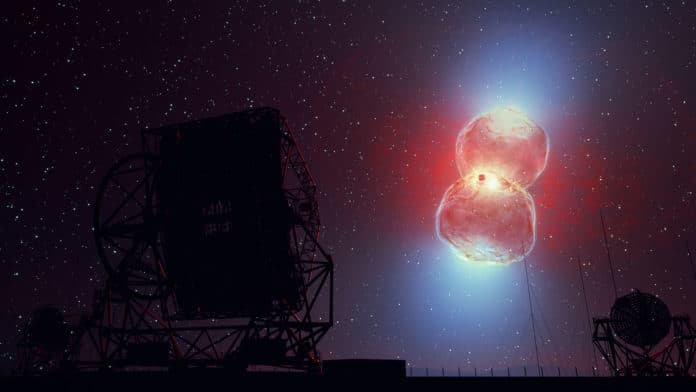For the first time, scientists have observed the course of an acceleration process in a stellar process called a nova. They saw powerful eruptions on the surface of a white dwarf. Thanks to the observations made with the gamma-ray observatory H.E.S.S. in Namibia, they observed such a cosmic particle accelerator as never before.
After exhausting their nuclear fuel, a white dwarf is what stars as the Sun become. A nova event occurs when a white dwarf within a binary system gathers material from its more massive companion due to its gravity. Some events occur repeatedly.
RS Ophiuchi is one of these recurrent novae; there is an explosion on its surface every 15 to 20 years. Using the H.E.S.S. system, scientists observed very-high-energy gamma rays from the recurrent nova RS Ophiuchi in August 2021. The particle acceleration was observed at energies several hundreds of times higher than previously observed in novae.
The particle acceleration reached the maximum speeds calculated in theoretical models: it efficiently releases energy into accelerated protons and heavy nuclei.
Ruslan Konno, one of the lead authors of the study and a doctoral candidate at D.E.S.Y. in Zeuthen, said, “The observation that the theoretical limit for particle acceleration can be reached in genuine cosmic shock waves has enormous implications for astrophysics. It suggests that the acceleration process could be just as efficient in their much more extreme relatives, supernovae.”
Scientists also followed the development of the nova, for the first time, during the eruption of RS Ophiuchi. It was like they were watching a film. They then measured high-energy gamma rays up to one month after the explosion.
For these measurements, they used specific telescopes. Five Cherenkov telescopes in the H.E.S.S. facility were used to investigate gamma rays from space.
Dmitry Khangulyan, a theoretical astrophysicist at Rikkyo University in Tokyo, Japan, said, “This is the first time we have ever been able to carry out observations like this, and it will allow us to gain even more accurate future insights into how cosmic explosions work. We may, for example, discover that novae contribute to the ever-present sea of cosmic rays and therefore have a considerable effect on the dynamics of their immediate surroundings.”
H.E.S.S. Director Stefan Wagner, a professor at the regional observatory in Heidelberg, explains, “Over the next few years, research using the C.T.A. telescopes will show whether this type of nova is special. We now have a clearer idea of what to look for. This gives rise to several new possibilities for gaining a better understanding and being better able to explain events linked to novae.”
“This measurement is a further success in gamma-ray astronomy and an encouraging sign that we will be able to study many more cosmic explosions with H.E.S.S. and gamma-ray telescopes of the future.”
Journal Reference:
- H.E.S.S. Collaboration. Time-resolved hadronic particle acceleration in the recurrent nova RS Ophiuchi. DOI: 10.1126/science.abn0567
